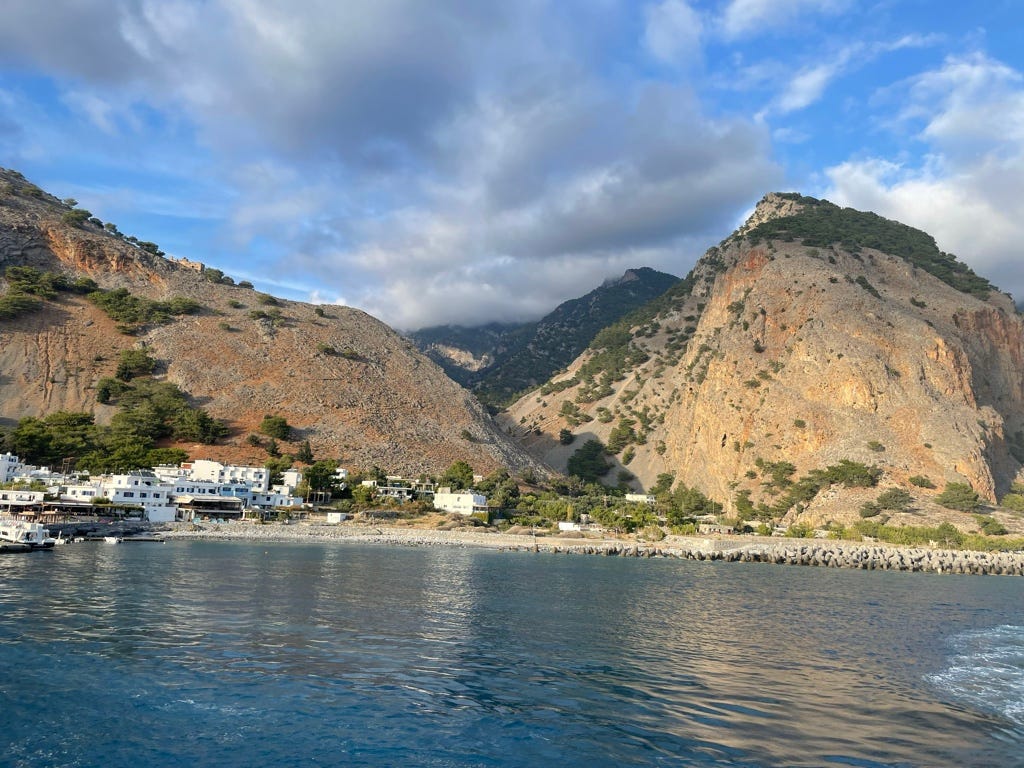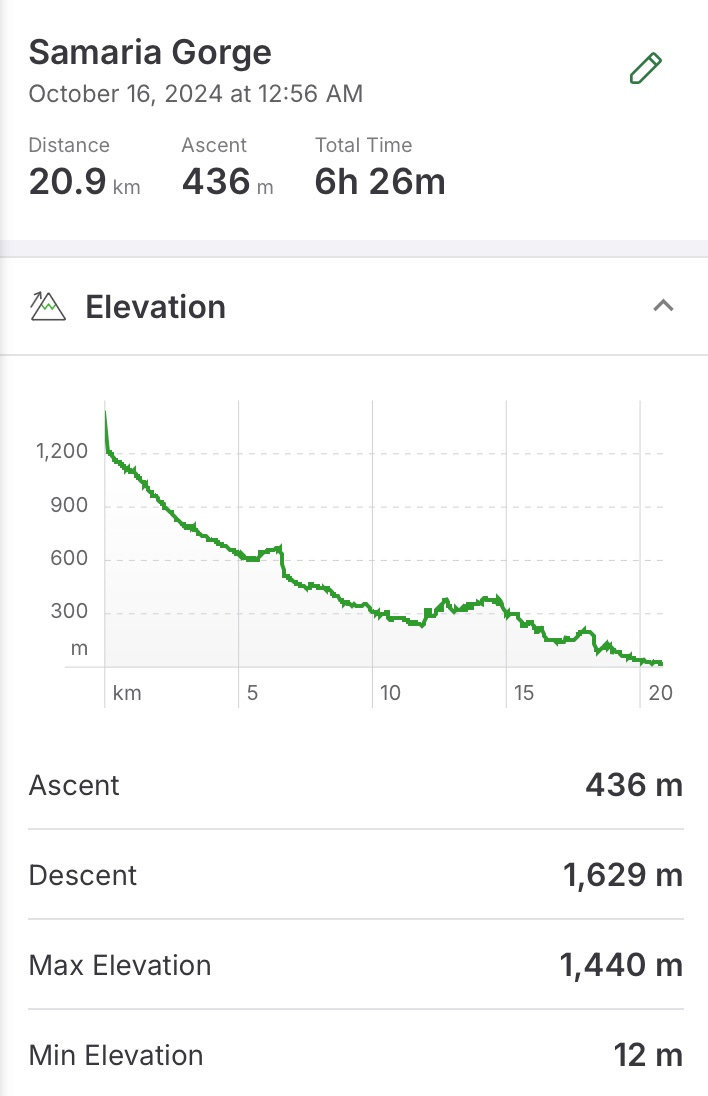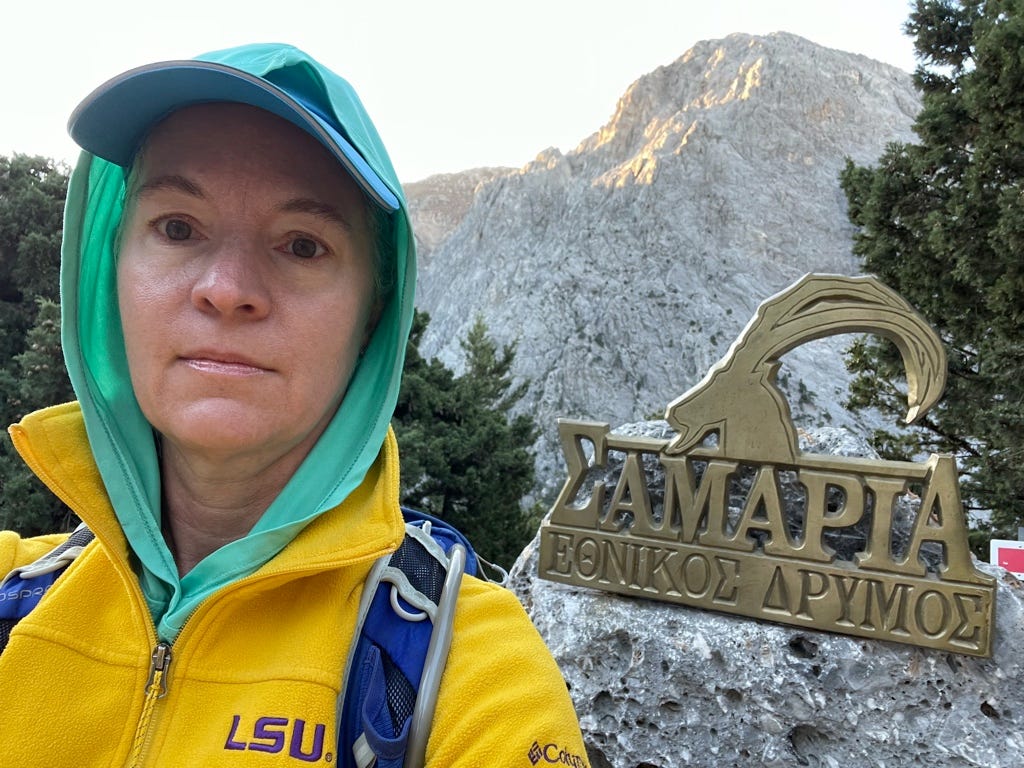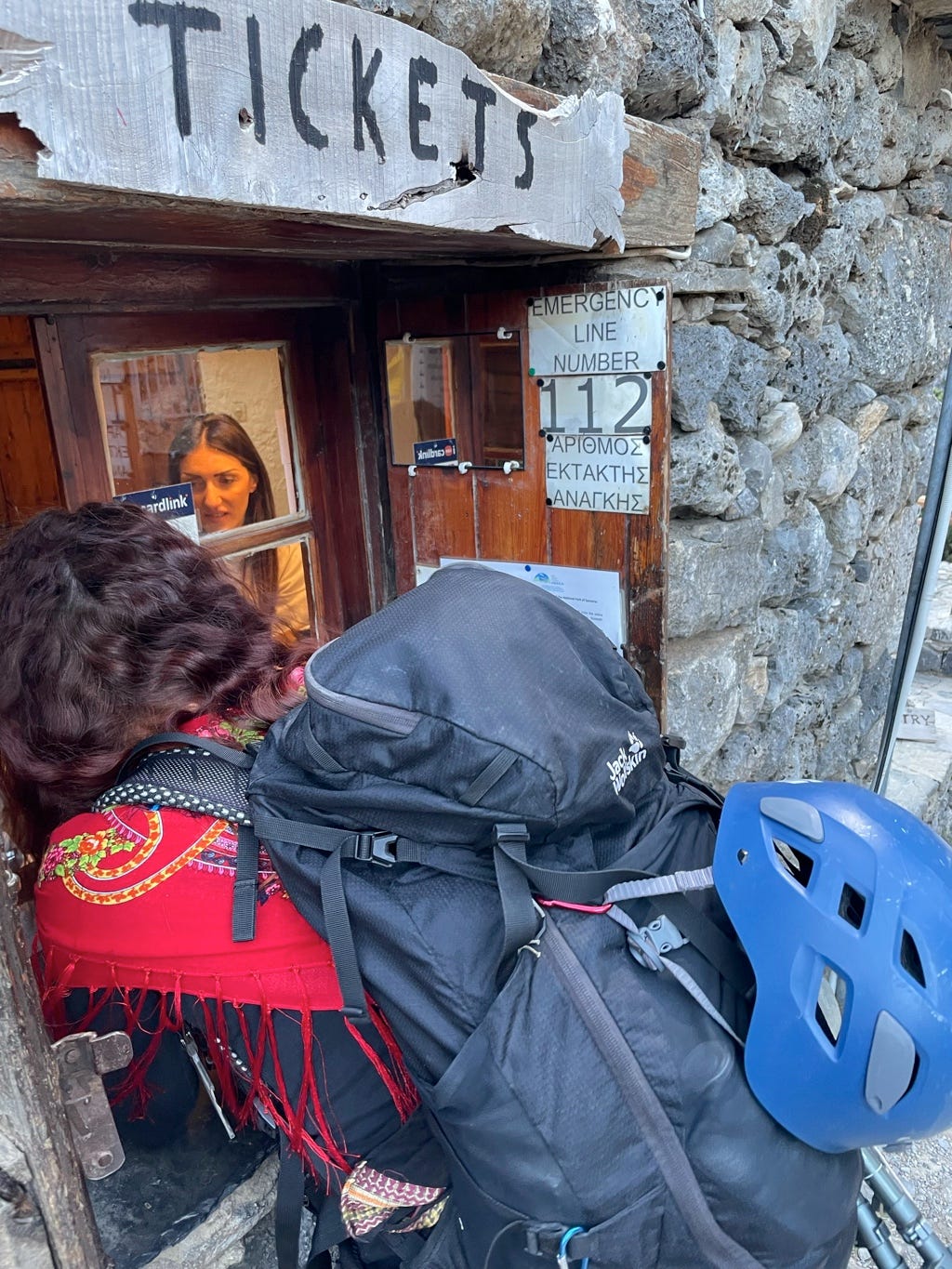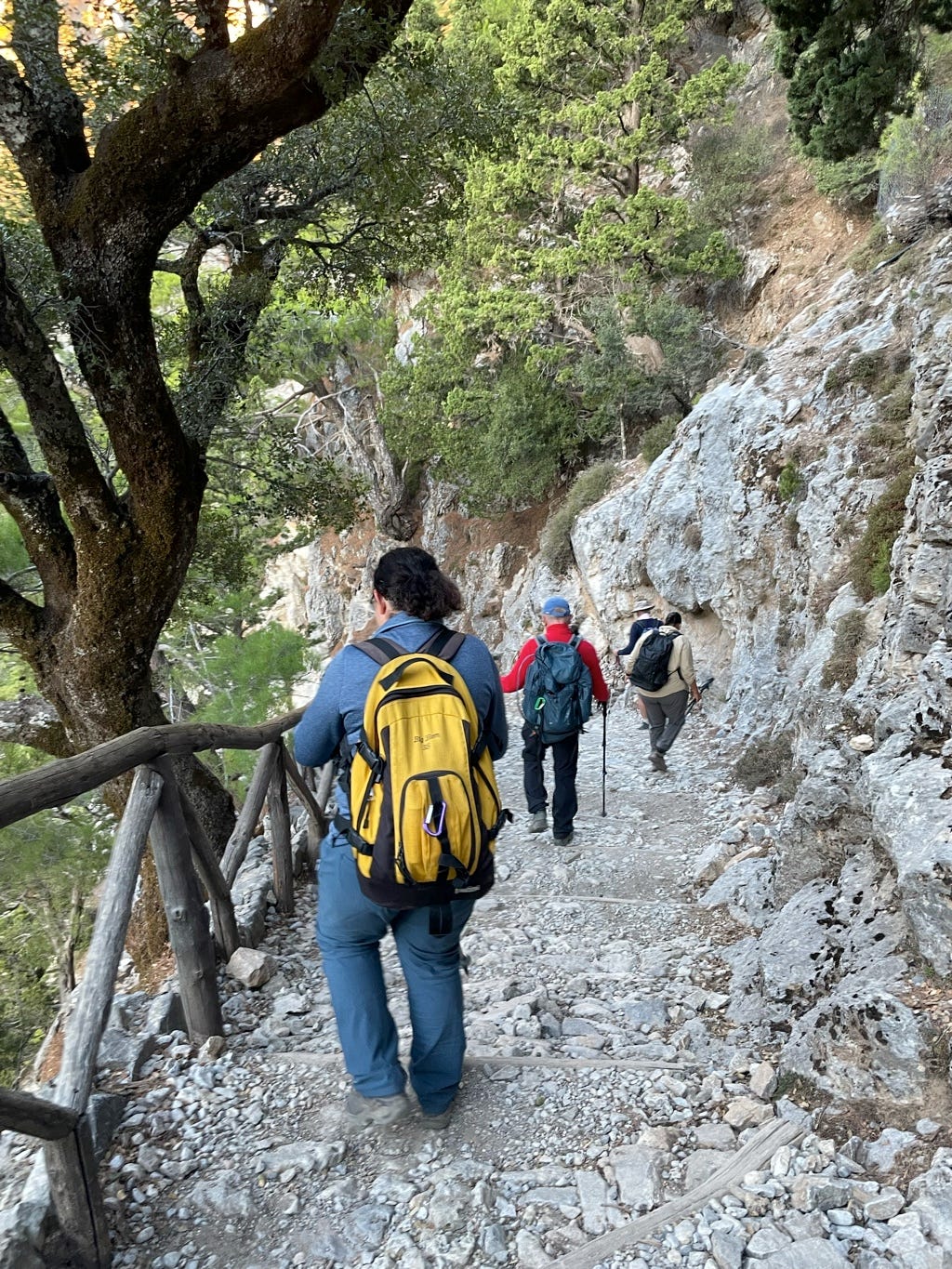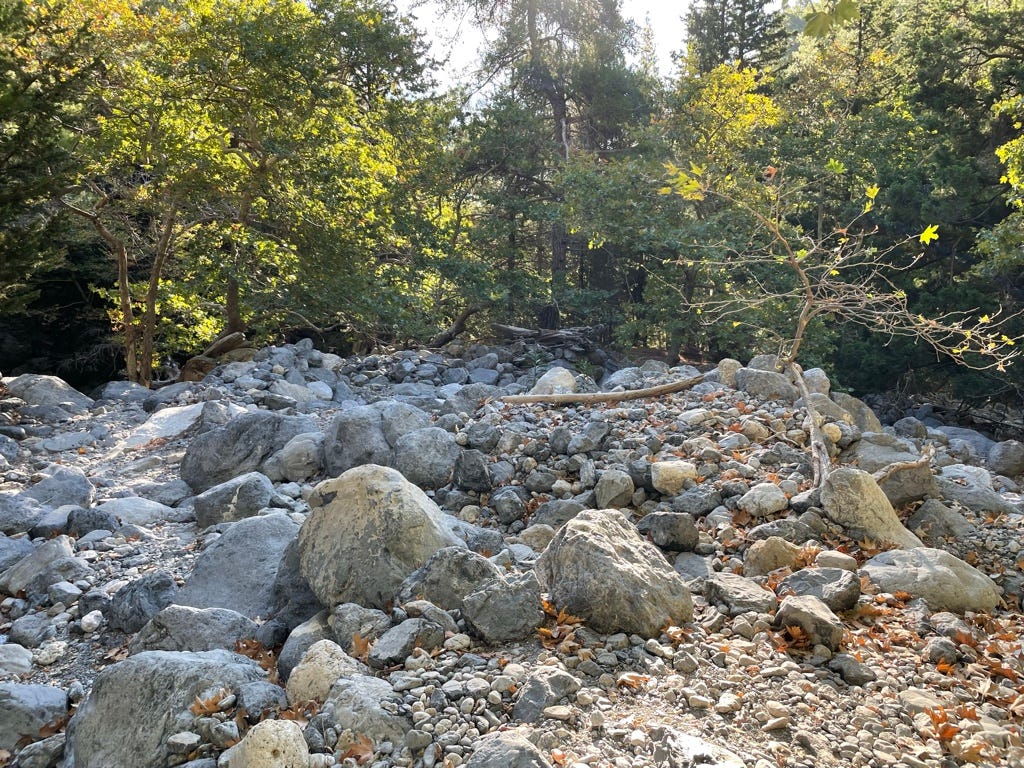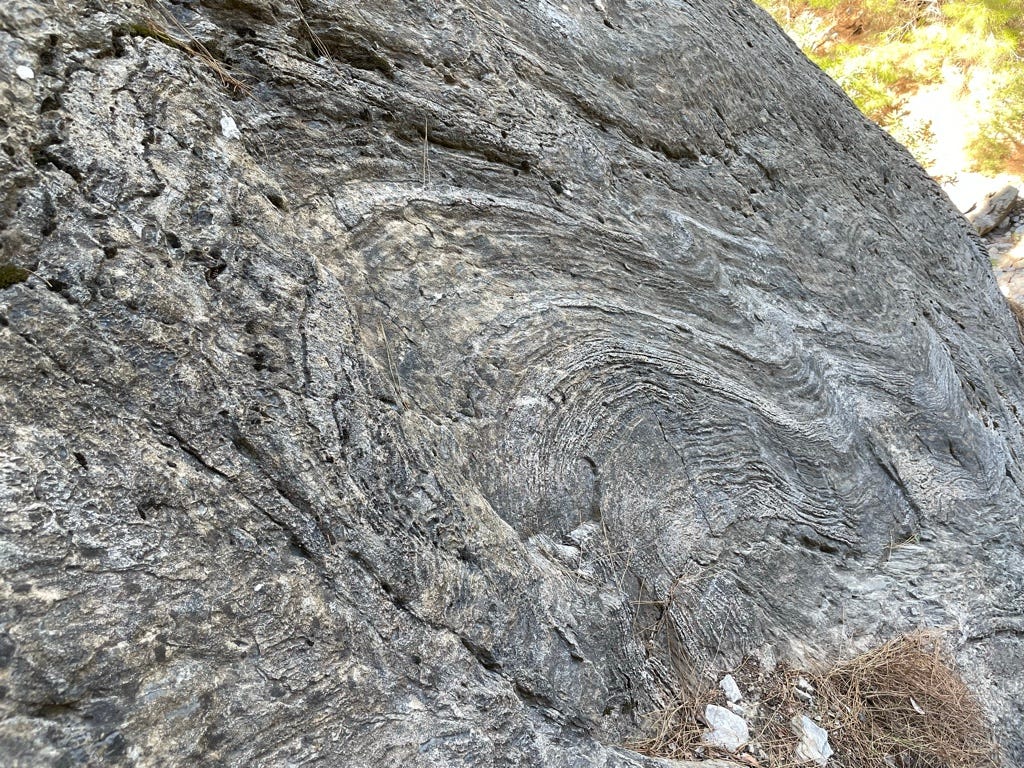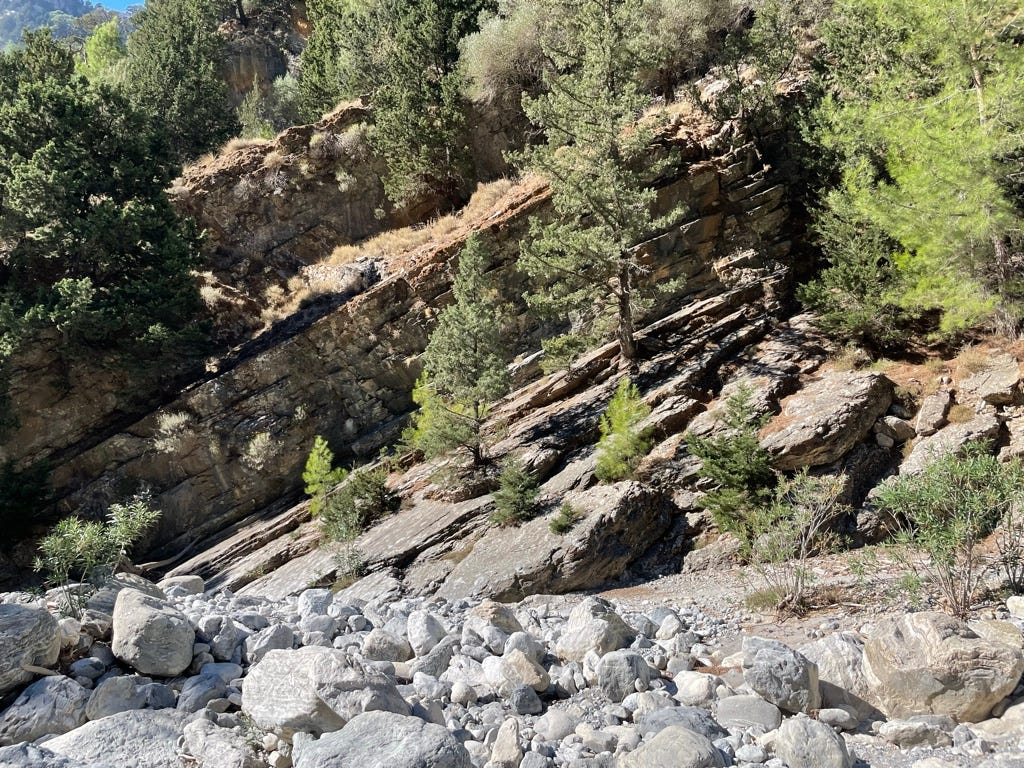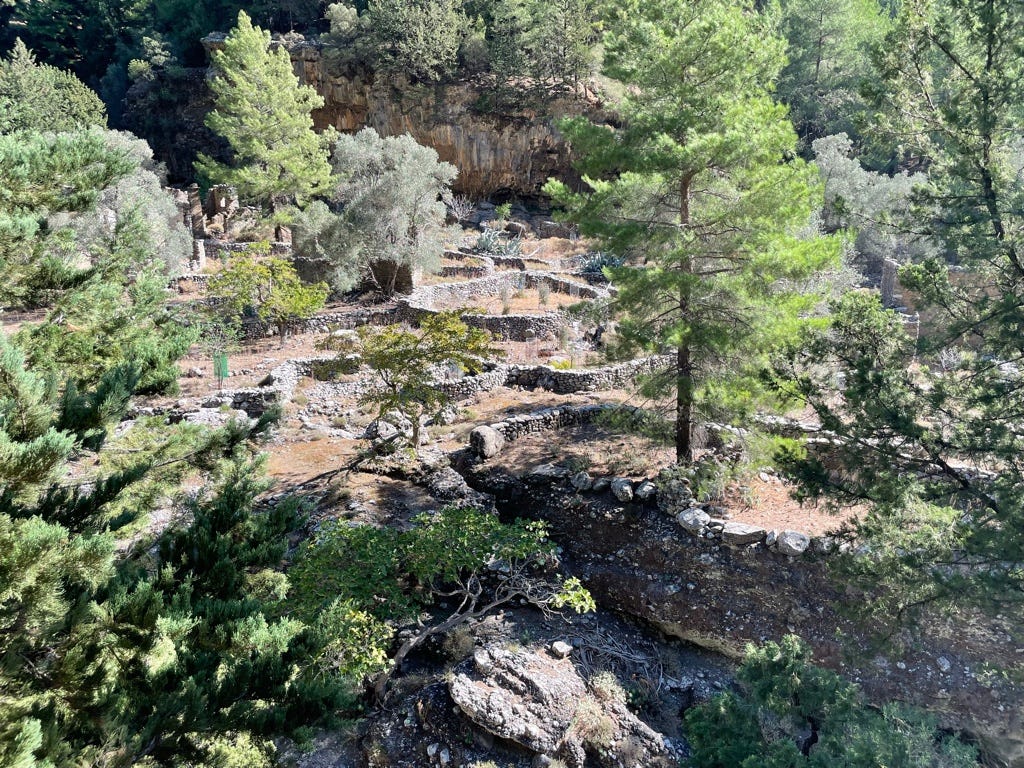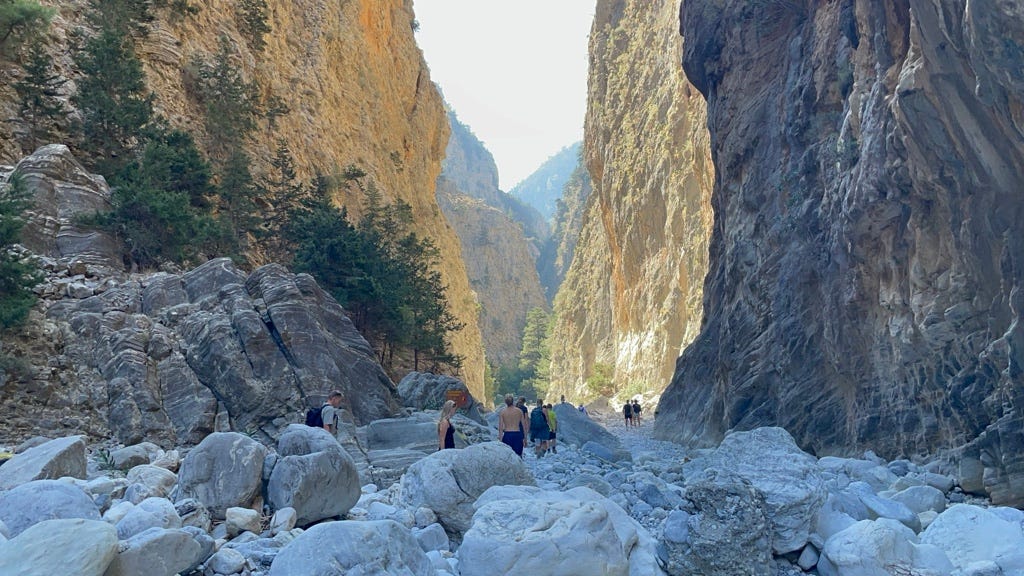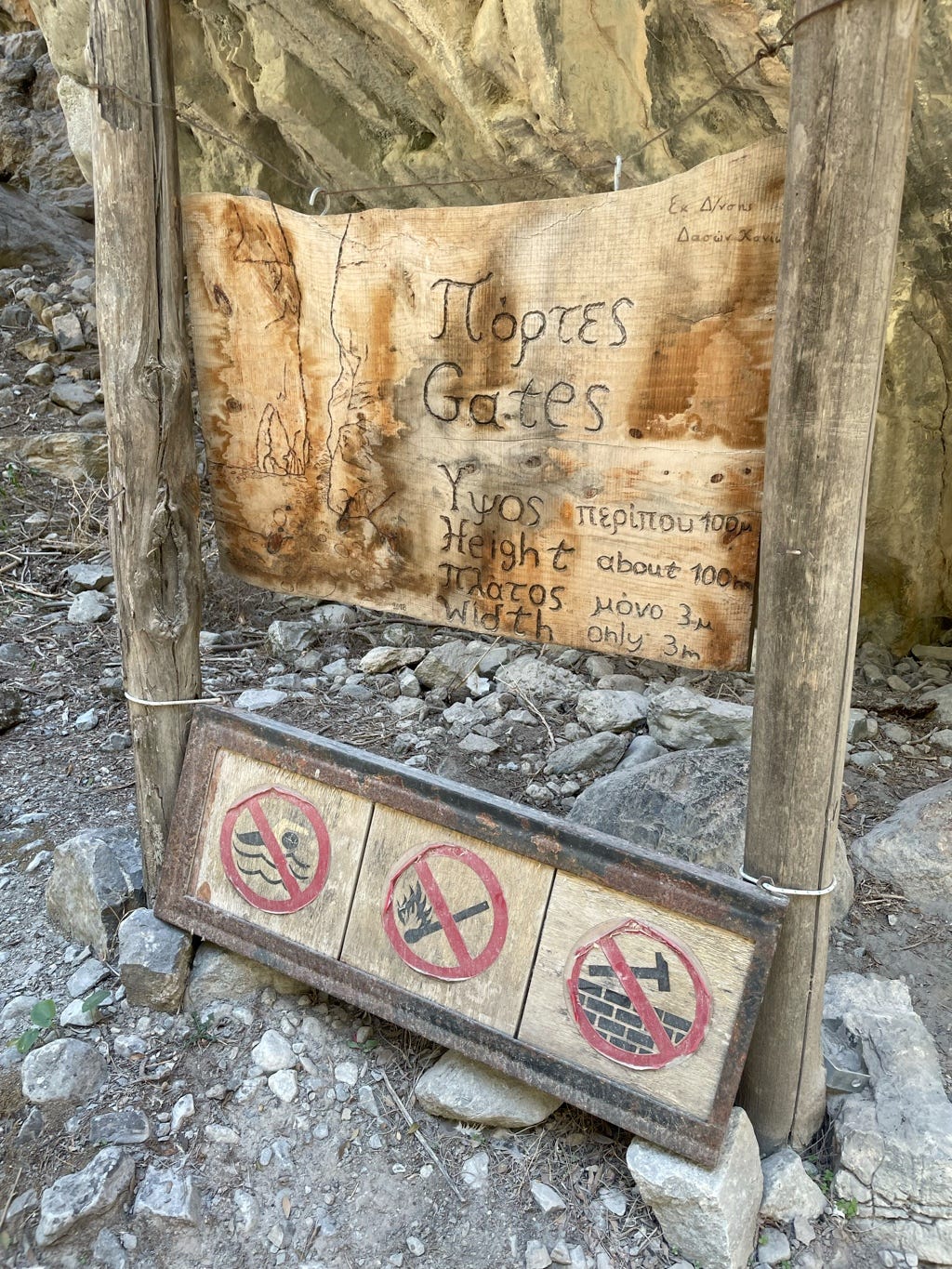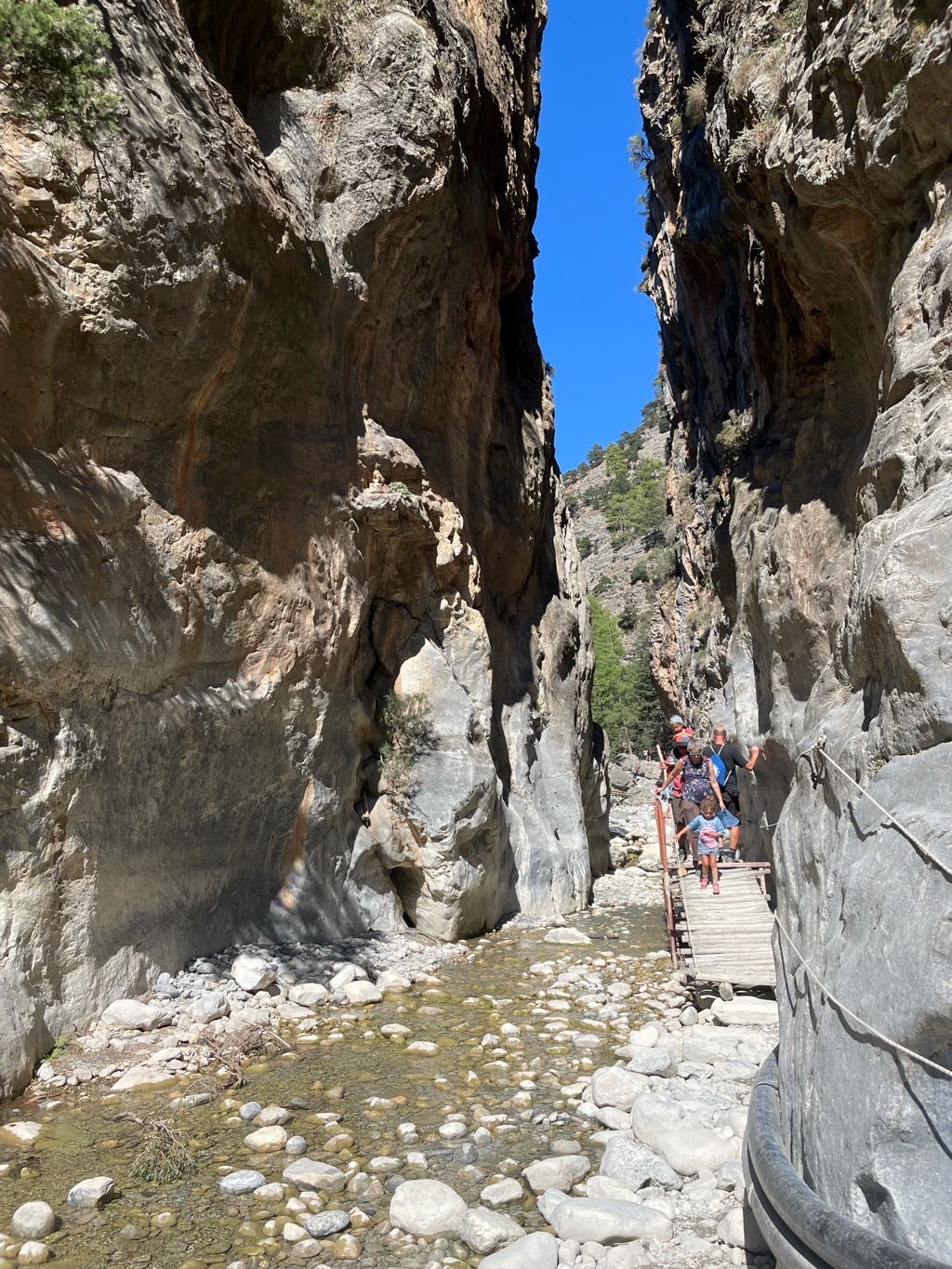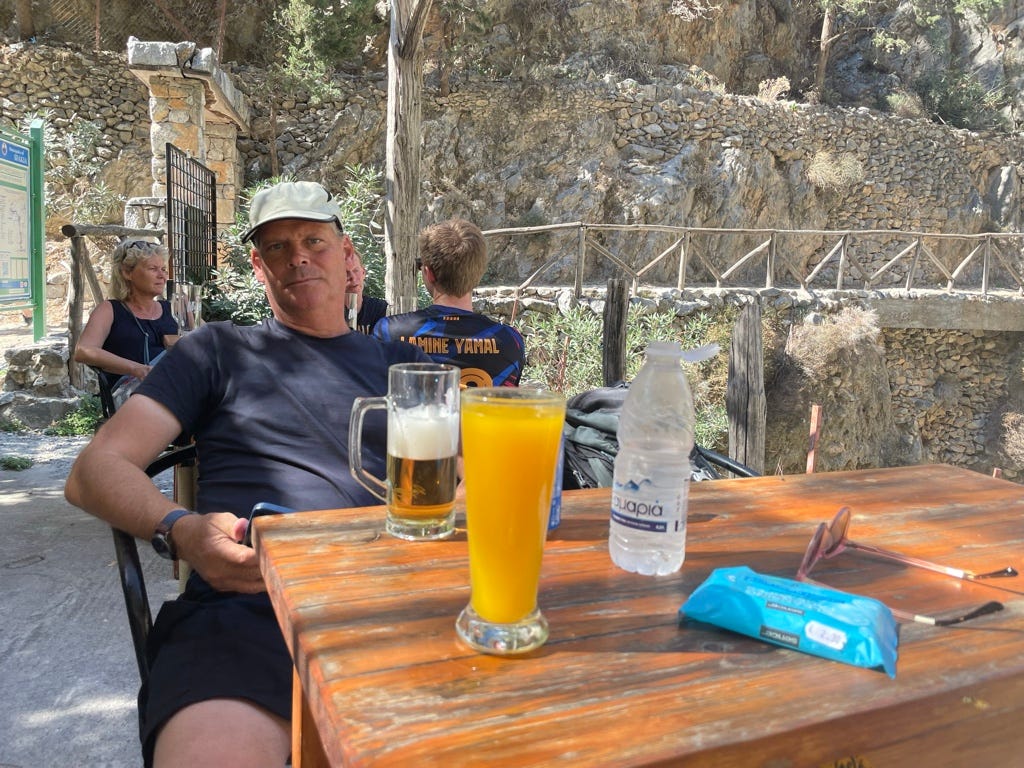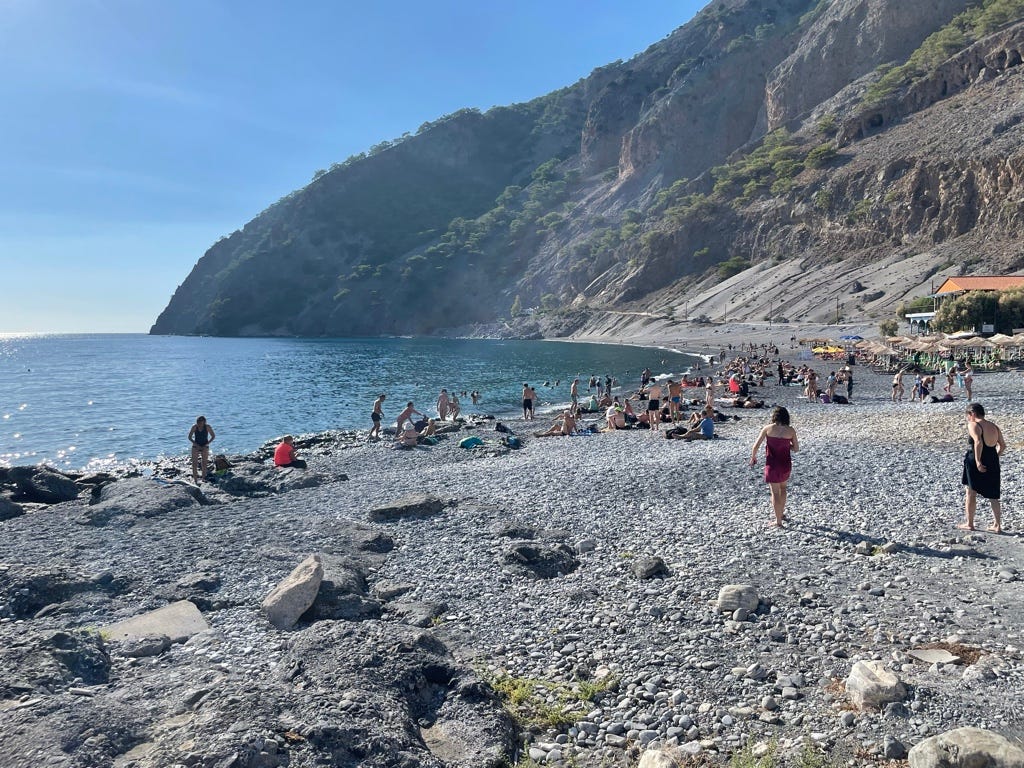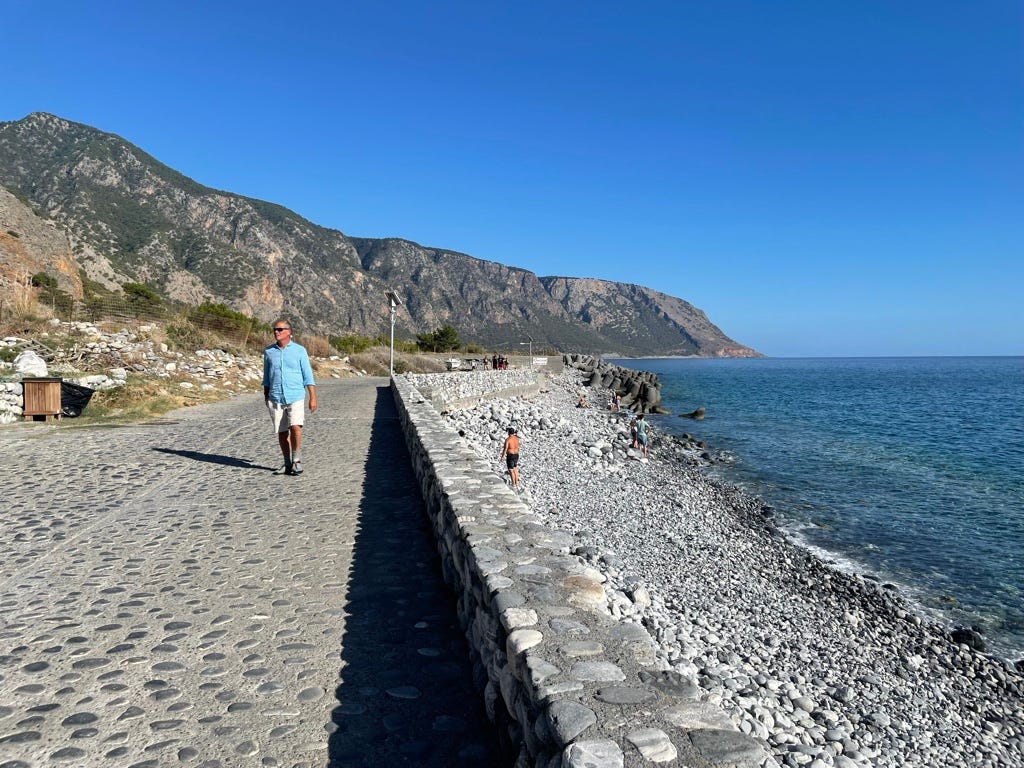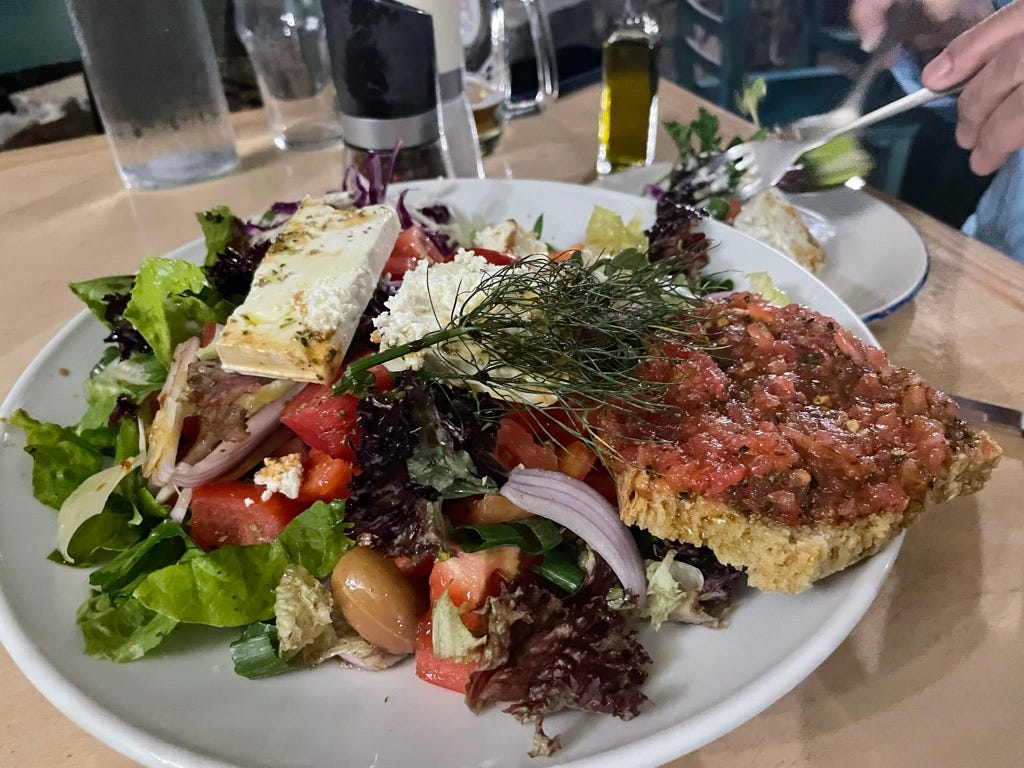This post is too long for email. To read the whole article, click the title.
Crete White Mountains. October 16: Samaria Gorge and Agia Roumeli
Samaria Gorge is up through that notch.
Map of the Samaria Gorge hike. You can see the Giglios trail (what we did of it) at the upper-left.
Stats for the hike. Not necessarily an easy day-walk for
Today we hiked the Samaria Gorge! Despite the gorge being pretty much universally closed all month, including the days before and after we did it, as our luck had it, it was open the very day we’d scheduled to walk it back in January.
Short version: it was fun! No problems whatsoever. We started at 8:00, were sitting at the café at the end by 1:30, and had plenty of time to enjoy our afternoon.
But there’s a lot to say about the Samaria Gorge.
Why is it closed all the time?
I’ve mentioned several times that the Samaria Gorge had been closed. That had happened when we’d visited Crete the previous spring–the gorge was closed due to bad weather or something. This particular week there was no explanation. But there are some good reasons why this place–the biggest tourist attraction in western Crete–is fairly frequently closed to the public.
The main reason is that it’s dangerous. Like, actually dangerous.
First, it’s geologically unstable, which means rocks fall off the walls, especially after hard rains. Just a month before we visited, a German tourist was killed by a rock that fell after a rainstorm.
More disturbing to us, it’s a firetrap. The terrain is dry much of the year, and there is no motorized transportation inside. A number of (very brave and strong-looking!) firefighters patrol the gorge and keep an eye on their water bags and hose systems, but I wouldn’t trust anyone’s chances if a real wildfire broke out in there.
It can also be very hot in the summer. Like, dangerously hot, which can only be exacerbated by the wall-to-wall summer crowds. A river does run through it, and there are springs here and there, but there’s no drinking water available in most parts.
So although the Samaria Gorge is a vital source of income for southwestern Crete, and some 250,000 tourists pay to enter it every year, the authorities do regularly close it.
NOT a walk in the park!
Though every hotel in Chania, Rethymno, and Heraklion sells a day trip to the gorge, Samaria Gorge is actually quite a difficult hike. It’s ten miles (16 km) from start to finish, which is a long way to walk in one shot. It’s far from the hardest trail in Crete, but it’s hard enough; there are plenty of rocks to jump over and rough crossings to sprain ankles. Attempting this in anything but sensible outdoor walking shoes is a fool’s errand. (Oh, and the initial staircase is very slippery, the rocks having been worn smooth by decades of feet.)
There’s no motorized transport inside. That means if you get hurt or sick and can’t continue, the only rescue is on the back of a mule, or perhaps on a stretcher carried by two burly pyrosvestis firefighters. Not even helicopters can reach most of the terrain.
Then there are the logistics. The uphill trailhead at Xyloscalo (staircase) is only 25 miles from Chania, but it takes a good hour to drive there. For reasons that will become clear in a moment, it’s not generally practical to leave a car at this trailhead expecting to get back to it that afternoon. Most tourists get dropped off as part of an organized trip, often a bus excursion or with a private guide.
If you walk from the mountains to the sea (the downhill route), you come out in the town of Agia Roumeli on the coast of the Libyan Sea. (You can’t see Libya from Crete, but it’s down there.) Agia Roumeli has no cars.
No cars???? But… then how do you get back to Chania (or Rethymno, or Heraklion)?
Well… by ferry, and then by bus. Two ferries leave Agia Roumeli around 5 p.m.. One sails west to Sougia, and one sails east to Chora Sfakion. In either of those places, our weary tourists board another bus, which drives them another 90 minutes or so back to their accommodations on the north coast.
This makes for a very long day outing. The morning pickups can be around 6:00 a.m. or even earlier to make the trailhead by 8:00 or so. Tourists return to their hotels around 7:30, 8:00, or possibly even later.
The ferry schedule creates its own stress. Young and fit people start popping out the south end around 1:00 p.m.. They make their way to the town of Agia Roumeli, where they can relax on the (black sand) beach or while away the afternoon (i.e., get their drink on) at a seaside taverna. The slower walkers, on the other hand, must find the time pressure stressful indeed. If they miss the ferry, they’re probably stuck in Agia Roumeli until the next day.
Can you bail? Sort of… Most people walk north to south, which is the downhill direction. That means if someone decides early on that they can’t manage the full distance and that it would be better to return to the trailhead, they have to turn around and walk straight uphill.
Our friend Yannis told us about a family he’d privately guided through the gorge. The mom and teenage sons were all gung-ho and eager to hike the gorge. Dad, on the other hand, maybe wasn’t in the best of shape. He made it to the bottom of the initial staircase, but it became clear that he was not going to do well on a nine-mile walk over rocks. It was decided that dad and Yannis would return to the trailhead while the mom and kids would do the hike. They agreed to meet up in Sougia that evening.
Yannis physically assisted his guest all the way up the staircase. At the top, they had to call a taxi to drive them to Sougia (an expensive and long trip!) Though it all worked out and the wife and kids had a lovely day, that afternoon sitting at a beachside taverna awaiting his family, the dad confessed that sitting on the beach was the trip he’d actually envisioned.
Oh, and there aren’t many restrooms. Like, very very few. Like… maybe one? There might be more, but we only saw one, and it had quite a line. Off-trail refreshment is discouraged and, in any case, privacy is severely lacking.
So although Samaria Gorge is sold as a must-do experience, and though it is indeed pretty cool to see, it’s not something to be taken lightly. If an extremely long day of walking on rough terrain (perhaps in crowds that rival those in Disneyworld) and riding on boats and buses isn’t your idea of a good time, maybe give it a miss. (Try Agia Irini instead, maybe? It’s much more relaxed, shorter, and no more complicated to get to.)
An alternative is to go to Agia Roumeli through other means (ground transport plus ferry) and walk UP the gorge some distance. It’s possible of course to go all the way to Omalos, but it would be pleasant enough just to walk as far as the famous Gates and then head back. Vacations shouldn’t be stressful!
Our own hike
This day started early. We meant to start early anyway, but the previous evening the hotel had suddenly informed us that our suitcases needed to be ready to go by 7:30 so they could get to Sougia in time to be put on the morning ferry to Agia Roumeli. Of course….
So we had breakfast at 7:00, dropped our suitcases at the door, and then boarded the 7:45 shuttle–no reason not to get an early start on the gorge!
The day started autumnal and windy! That didn’t last, though. You can see Mt. Gigilos in the background.
Everyone has to buy a ticket to enter the gorge and relinquish it at the far end. That’s how the staff makes sure everyone is out at the end of the day.
The start of the hike is a long descent down a rocky staircase. The rocks are worn smooth, which makes them slippery–this is probably the most dangerous part of the hike.
The bottom of the gorge is rocky.
The Samaria gorge was an inspiration to geologists in the early days of the field, and you can really see why. The history of the land is written right in the rocks.
Strata, or layers, which give us the study of stratigraphy.
Evident uplift; look at the diagonal tilting!
Toward the south end of the gorge are the ruins of the old town of Agia Roumeli.
The width of the gorge varies. In some places it’s quite wide. The narrowest bits are toward the south.
It really looks like a canyon here!
The walking is rough. It really wouldn’t be ideal for someone who struggles with balance.
The most famous bit of the gorge is the Gates, or Iron Gates, which are about 3 meters wide. This must be quite the logjam on busy days in the summer!
Though there are some narrow bits that you might think are the Gates, it’s a safe assumption that the money shot of the whole site will have a sign.
Approaching the Gates from the north.
And looking back from the south.
At the end of the official Gorge trail, tourists hand over their tickets and then exit to a collection of cafés. We made it there by about 1:30.
The drink menus are compact: you can get beer or orange juice.
We watched a couple of lammergeiers flying over the gorge.
Refreshed, we headed out to walk the last kilometer to the town of Agia Roumeli. There are vans that will transport you to town for a fee. It didn’t seem worth it to pay for such a short drive, though this would be a godsend for people with kids or blisters on their feet.
Agia Roumeli
Agia Roumeli. The named “roads” are footpaths.
Agia Roumeli is a very small town on the Libyan Sea. You can’t drive there; the only way to get there is to take a ferry from Sougia or Chora Sfakion or to walk there through the gorge. There’s not a heck of a lot to do. There’s a beach, if you don’t mind black, rocky sand.
Agia Roumeli and the mouth of the Samaria Gorge
Agia Roumeli’s black sand beach
Predictably, hiking is popular. The E4 trail runs both east and west from Agia Roumeli, but Eleni in Chania had told us that they NEVER take tourists on the section between Agia Roumeli and Sougia to the west. It’s reportedly very exposed, rough, and downright dangerous. We ourselves would be heading east the next morning.
Some tourists walk up to the Turkish castle visible on the ridge at top right.
The vast majority of tourists who walk there leave on the afternoon ferry, which makes for lively afternoons but quiet nights.
The ferry dock.
A quiet waterfront.
We had dinner at the restaurant Rousios, which lived up to its very good reviews. And the local rosé wine was to die for!
The evening special at Rousios.
That special might be the most delicious meal I’ve ever had!
We started with a very excellent horiatiki.
The name “Agia Roumeli” is funny. You might think it means “Saint Roumeli,” but who was Roumeli? The answer is, no one. “Agia” in this case doesn’t mean “holy”. The name is thought to be a corruption of the Arab words “Aia Rumeli,” or maybe “Aqua Roumeli,” which might mean “Waters of the Romans”. “Romans” in this case meaning Greeks.
It was wonderful to have reached the southern reaches of the Aegean world. Just the name “Libyan Sea” suggests the imminent presence of Africa.




